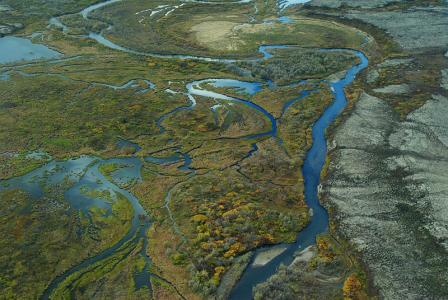
Sensitive wetlands hosting the world’s largest sockeye salmon run flow into Bristol Bay. Credit: US Environmental Protection Agency
Guest Commentary:
By Bill Carter
Mother Nature has a way of reminding us that humility is a trait that humans too often lack. Take, for instance, the engineering firm Knight Piesold, which stated that “modern dam design technologies are based on proven scientific/engineering principles and there is no basis for asserting that they will not stand the test of time.”
Until they don’t. Earlier this month a tailings dam designed by Knight Piesold at the Mount Polley copper mine breached, dumping up to 10 million cubic meters of heavily contaminated water into surrounding streams, rivers and lakes in central British Columbia. Since the accident aerial photographs show a massive mudslide attacking the tranquil waters of a nearby salmon stream and dumping into Quesnal Lake. The salmon run will most likely perish, along with the entire ecosystem that the salmon and other species rely on for life.
Even so, the company is probably off the hook. Full disclosure: The quotation at the beginning of this essay is not related to the Mount Polley mine; Knight Piesold offered up the above assurance in defense of the proposed Pebble mine in southwest Alaska.
The Pebble mine would be one of the largest mines ever built. The deposit is huge, with a market value ranging from $350 billion to $500 billion of copper and gold. It is also at the headwaters of the world’s largest wild sockeye salmon fishery. Almost 40 million young salmon returned to the Bristol Bay watersheds to spawn this year. Along the way these phenomenal salmon runs generate more than $1.5 billion annually and support 14,000 jobs and a Native American culture that relies on the salmon dating back thousands of years.
The mine plan calls for three earthen dams, all among the tallest in existence and similar in design to the one that just broke. Behind these dams will be 10 billion tons of the same toxic cocktail that just wreaked havoc in British Columbia. In addition, the region lies in the “ring of fire,” with a smoking volcano, and lies close to three fault lines. In 1964 Alaska experienced the largest-ever recorded earthquake, which registered at 9.4 on the Richter scale. The industry standard is for a dam to stay structurally sound up to a magnitude-7.5 quake.
After spending years talking to mining executives, engineers and hydrologists, I have learned a valuable lesson: Everything mining companies do fits into a cost/benefit analysis of risk. If they have a major mining accident and it threatens the salmon run, they simply pit that cost against the benefit of mining billions of dollars of minerals. The salmon run is not seen in the bigger picture as a food source or job creator; operating at a profit is the priority. Paying for mistakes is worth it if the math works, even if it means compromising our clean water and food.
The EPA has made a bold stand to protect the salmon fishery from development of the Pebble mine, but they need our help. They need the numbers to be on their side. Not the scientific numbers; they did their work and have plenty of science that clearly states that this mine is a bad idea. What they need are ordinary people to participate in the comment period of their plan review. It’s simple: The more people say they are against the mine, the more leverage the EPA can apply. It is unprecedented in our country’s history to shut down a potential mine this big. We don’t do that. In general, government at both the federal and state level has always helped mining companies build.
It has never been more in-vogue or accurate to utter the phrase “the government does nothing.” Well, this is one of those times that they are doing something. Protecting our last viable and sustainable salmon run is in the national interest. Please take a moment to tell the EPA that you want to save Bristol Bay from the Pebble mine. (Comments will be received until Sept. 19, 2014.) It is time to value our wilderness with the same metrics that we value the shiny stuff in the ground.
Bill Carter is the author of Boom, Bust, Boom: A Story About Copper, the Metal That Runs the World and Red Summer: The Danger and Madness of Commercial Salmon Fishing in Alaska. Carter is an assistant professor of practice in documentary studies at Northern Arizona University in Flagstaff, Arizona.
© Copyright 2014 John Dougherty, All rights Reserved. Written For: Investigative MEDIA
Leave a Reply